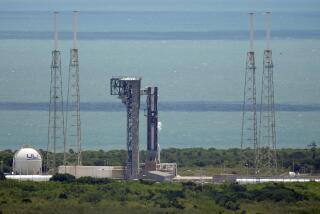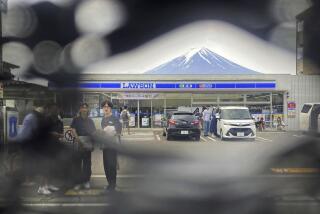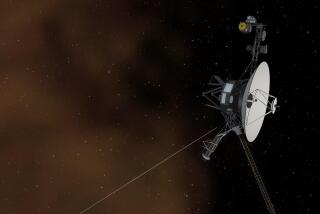Effort to Fix Space Probe’s Antenna Fails : NASA: Device on Jupiter-bound craft remains jammed. Failure to deploy it will severely reduce the number of photos that can be relayed to Earth in 1995.
- Share via
Repeated “hammerings” of a balky ball nut on the Jupiter-bound Galileo space probe failed to force open a jammed antenna early Wednesday, and disappointed NASA officials decided to postpone additional repair efforts until Jan. 5.
Engineers had switched on a small electric motor at 7 a.m. PST Tuesday and left it on for 20 seconds. This was designed to take up all the slack in the mechanism that drives open the 16-foot-wide, gold-plated molybdenum-mesh high-gain antenna, which resembles an inverted umbrella.
Two hours later, they instructed the $1.5-billion satellite’s on-board computer to switch the same motor on and off 180 times in 2 1/2 minutes, in the hopes that these rapidly repeated pulses would “hammer” open the stuck antenna.
The process was repeated 11 more times throughout Tuesday and into the early morning on Wednesday. Galileo Project Manager William J. O’Neil said the hammering did turn the mechanism’s drive shaft one full revolution, increasing pressure on the jammed parts but failing to force open any of its stuck ribs.
Based on information received from the satellite and studies of a mock-up on Earth, engineers at NASA’s Jet Propulsion Laboratory in Pasadena have concluded that three of the antenna’s 18 graphite composite ribs are probably stuck in the folded position.
This, they believe, most likely was caused by the loss of lubricant as the satellite was repeatedly trucked between Florida, where it was made and ultimately launched into space, and California, where it was attached to the rest of the satellite and later modified.
Engineers had hoped to free the stuck antenna on the first day of this hammering method because the satellite still is relatively close to the sun, and thus its components are warm and malleable.
“The prospects dim with time, so I’m disappointed we didn’t succeed,” O’Neil said.
Nonetheless, he said that in the two weeks beginning on Tuesday engineers are planning an “aggressive” effort to continue hammering on the antenna, which would enable the satellite to send back tens of thousands of photographs of Jupiter after it arrives in late 1995.
Without the high-gain antenna, which focuses radio transmissions into a narrow and powerful beam, Galileo would have to rely on a low-gain device that sends data at a much slower rate. O’Neil said the low-gain antenna could transmit 3,000 to 4,000 photographs, compared to 60,000 photos expected from the faulty high-gain device.
Even using the low-gain antenna, Galileo could transmit large amounts of information on the nature and composition of the solar system’s largest planet and its four major moons.
Scientists are particularly eager to study Jupiter in detail because they think it may hold answers about how the solar system was formed. Scientists think that Jupiter, of all planets, retained the largest amount of the gas and dust out of which the solar system condensed.
The interplanetary probe was launched from the space shuttle Atlantis on Oct. 18, 1989, and is scheduled to arrive at Jupiter late in 1995. Galileo already has given the world its first close-up look at an asteroid--Gaspra--and is scheduled to encounter another asteroid, Ida, next August.
More to Read
Sign up for Essential California
The most important California stories and recommendations in your inbox every morning.
You may occasionally receive promotional content from the Los Angeles Times.










